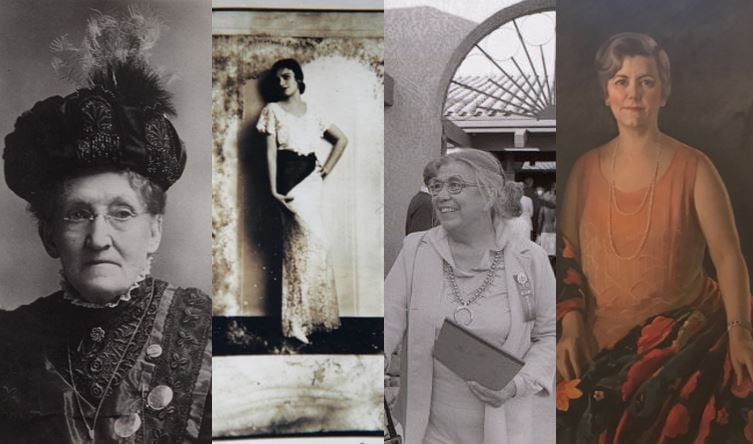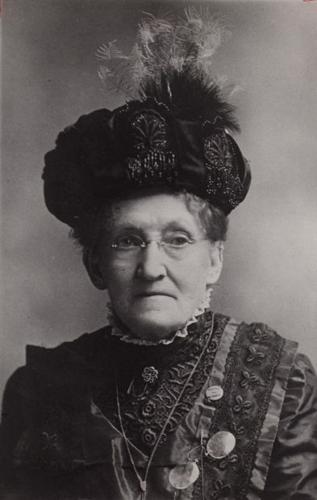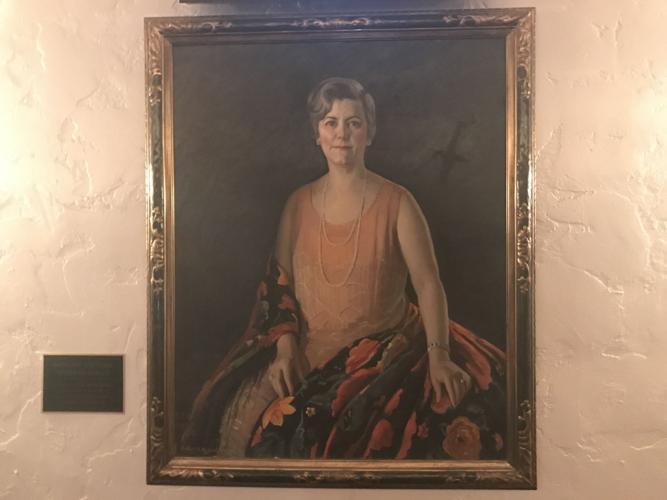March is the month when we celebrate the women who have gone before — those who stood up, spoke out and made history.
March is Women's History Month, and Tucson's past has no shortage of sheroes.
You may not have heard these women's stories in your history class (we're looking at YOU Father Kino.) But we are trying to remedy that this month with weekly reminders of Tucson's ladies of lore.
Starting with...
Josephine Brawley Hughes
1839-1926

Josephine Brawley Hughes in 1887.
Josephine Brawley Hughes traveled to Tucson in the early 1870s with a baby on one hip and a loaded rifle on the other, watching for anyone that might threaten her stage coach.
Hughes was following her husband, an attorney who had moved out to the dusty Southwest to open a law office. Born in Pennsylvania, the young mom made it to San Francisco by train, San Diego by boat and Tucson by stage coach.
Upon arrival, she infused her frontier-town home with touches from her East Coast life — carpet in the parlor, grass in the front, candles for light and a cistern for water.
We'll admit, we're fans of Hughes' — for a while, she ran the Arizona Daily Star.
Hughes meant business whether people agreed with her or not (and many did not).
During her lifetime in Tucson, she:
• Taught in Tucson's only public school for girls.
• Traveled to Philadelphia for the nation's Centennial as the Commissioner for Arizona to the Women's Department.
• Helped to organize and fundraise for the first Protestant church in Arizona — a Presbyterian congregation — and later backed the first Methodist church in town.
• Used her husband's position as owner of the Arizona Daily Star to advocate for causes dear to her heart. Among them: Higher education, temperance, women's suffrage and the removal of bands of raiders during a time of conflict between Southwestern settlers and Apaches. She did not let saloons advertise in the paper and changed the Star's payday from Saturday to the beginning of the week so employees would not blow their paychecks on alcohol.
• Stayed in Tucson to take over the management of the Star when her husband Louis C. Hughes became territorial governor in 1893.
• Helped found the Arizona Suffrage Association.
• Raised a son who became a senator in the first Arizona state legislature and introduced a state constitutional amendment to let women vote even before Congress passed the 19th Amendment. That bill passed in 1912, letting Arizona women vote years before Congress said so.
• Was inducted into the Arizona Women's Hall of Fame in 1990.
Sources: "Levi's and Lace: Arizona Women Who Made History" by Jan Cleere; the Arizona Women's Hall of Fame; "Western Women: Meet Crusader Elizabeth Josephine Brawley Hughes" by Jan Cleere for the Arizona Daily Star.
Maria Luisa Legarra Urquides
1908-1994

Maria Urquides, center, wouldn’t put up with policies that forbade teaching kids in their native languages.
Maria Luisa Legarra Urquides put herself through what is now Arizona State University by cleaning toilets — and singing a bit at a local restaurant.
Born and raised in Tucson as a third-generation Mexican American, Urquides grew up in a school that forbade her from speaking Spanish. Only English would do.
Upon her graduation from the Arizona State Teachers College at Tempe (ASU) as valedictorian, she returned to Tucson to teach at the segregated Davis Elementary School.
Although her students were mostly Mexican American and Yaqui, the same rules from her childhood applied: Teach only in English.
That fueled her life's passion for bilingual education.
During her lifetime in Tucson, she:
• Taught for 20 years at Davis Elementary School and upon transferring to Sam Hughes Elementary, a mostly Anglo school with better resources, began her quest for bilingual and multicultural education.
• Helped establish Oury Park and a recreation center complete with library, auditorium and swimming pool.
• Worked with other teachers to create the report "The Invisible Minority," based on surveys exploring bilingual education in schools in five southwestern states.
• Served on the White House Conference on Children and Youth multiple times after separate appointments by presidents Harry S. Truman, Dwight D. Eisenhower and Richard M. Nixon. The presidential respect continued when President John F. Kennedy assigned her to the Arizona State Advisory Committee to the Civil Rights Commission and President Lyndon B. Johnson appointed her to a national advisory committee on Mexican-American education.
• Taught Mexican teens at Pueblo High to read and write in their native Spanish and eventually became the high school's dean of girls.
• Developed a reputation as "Mother of Bilingual Education."
• Served and led many organizations that advocated for women, education and cultural studies.
• Was inducted in the Hispanic Hall of Fame and the Arizona Women's Hall of Fame in 2002 and received numerous awards for her work from organizations such as the University of Arizona, the YWCA and the National Association for Bilingual Education.
Sources: "Levi's and Lace: Arizona Women Who Made History" by Jan Cleere; "Western Women: Mother of bilingual education enterprising from young age" by Jan Cleere for the Arizona Daily Star; the Arizona Women's Hall of Fame.
Cele Peterson
1901-2010

A 1940s Arizona Daily Star ad says you can get silk and wool dresses that are "simple enough for the office and smart enough for anywhere" for less than $20 at Cele Peterson's.
Debbie Reynolds did, so did Elizabeth Taylor and the rest of Tucson.
It was her Southwest-inspired apparel called "Station Wagon Togs" that attracted so many people. Everyone knew her and her shop on Pennington Street that survived the Great Depression, World War II, and a fire in 1956 that injured many employees.
She was Tucson's fashion icon for 75 years. And just look at her. Her style is still inspiring.
During her lifetime in Tucson, she:
• Opened the Cele Peterson Shop on Pennington Street, along with other stores around the city.
• Was one of the founders of the Children's Museum.
• Hosted a local radio show called "Star of the Day."
• Provided a building for Sister Kathleen Clark to open Casa de los Niños.
Sources: "Tucson fashion pioneer Cele Peterson passes at 101" by Bonnie Henry (2010) and "Cele Peterson dies at 101" by Daniel Buckley (2010).
Madeline Heineman Berger
1875-1943
Madeline Berger was the driving force behind the creation of the Temple of Music and Art on Scott Avenue.

This portrait of Madeline Heineman Berger hangs in the lobby of the Temple of Music and Art. She's beauty, she's grace.
She loved the arts so much that she started a club of Tucson women that also loved the arts called the Saturday Morning Musical Club.
The Temple got its start because Madeline's growing club needed a place to meet and perform.
Madeline wanted a sacred space for the arts and a temple is what she got. But it wasn’t easy, she struck a deal with wealthy snow bird and brother-in-law Alexander Berger. He agreed to donate most of the money if she could get donations from other Tucson merchants.
Thousands of people came to the opening of the Temple in 1927. It became quite the attraction in Tucson because of the shows it put on and the people that performed there.

The Temple of Music and Art, 330 S. Scott Ave., the home of the Arizona Theatre Company, was built in 1927 and went through renovations in 1988-1989.
The temple became Madeline's whole life. She even had her funeral at the Temple when she died in 1943.
Now the Temple of Music and Art is the home to the Arizona Theatre Company. Madeline’s portrait hangs in the lobby and there’s a mediterranean restaurant called Simplicit by the courtyard. A lot has changed over the years but we think she’d be glad to know that the arts are still being honored in that building.
During her lifetime in Tucson, she:
• Founded the Saturday Morning Musical Club, a group of amateur but talented performers and art enthusiasts.
• Became and remained president of the club for more than 30 years.
• Opened and founded the Temple of Music and Art.
• She sponsored the first program of the Tucson Symphony Orchestra.
Sources: "Madeline Berger built her Temple" by Bonnie Henry (1989) and "The Saturday Musical Club celebrates its 50th Birthday" by Barbara Sears (1957).









